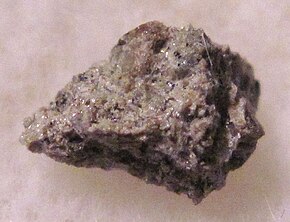

| Shergotty meteorite | |
|---|---|

50 milligram fragment of the Shergotty meteorite
| |
| Type | Achondrite |
| Class | Martian meteorite |
| Group | Shergottite |
| Parent body | Mars |
| Country | India |
| Region | Sherghati, Gaya district, Bihar |
| Fall date | 1865-08-25 |
| TKW | 5-kilogram (11 lb) |
| Alternative names | Sherghati meteorite |
The Shergotty meteorite (Named after Sherghati) is the first example of the shergottite Martian meteorite family. It was a 5-kilogram (11 lb) meteorite which fell to Earth at Sherghati, in the Gaya district, Bihar, India on 25 August 1865, and was retrieved by witnesses almost immediately.[1] Radiometric dating indicates that it solidified from a volcanic magma about 4.1 billion years ago.[2] It is composed mostly of pyroxene and is thought to have undergone preterrestrial aqueous alteration for several centuries. Certain features within its interior are suggestive of being remnants of biofilm and their associated microbial communities.[3]
|
Meteorites by name
| |
|---|---|
| A–B |
|
| C–D |
|
| E–F |
|
| G–H |
|
| I–J |
|
| K–L |
|
| M–N |
|
| O–P |
|
| Q–R |
|
| S–T |
|
| U–V |
|
| W–X |
|
| Y–Z |
|
| |
|
| |||||||||||||||||||||||
|---|---|---|---|---|---|---|---|---|---|---|---|---|---|---|---|---|---|---|---|---|---|---|---|
| Meteorite... |
| ||||||||||||||||||||||
| Classification |
| ||||||||||||||||||||||
| Mineralogy and petrology |
| ||||||||||||||||||||||
| Lists |
| ||||||||||||||||||||||
| |||||||||||||||||||||||
|
| |||||||||||||||
|---|---|---|---|---|---|---|---|---|---|---|---|---|---|---|---|
| Disciplines |
| ||||||||||||||
| Main topics |
| ||||||||||||||
| Planetary habitability |
| ||||||||||||||
| Space missions |
| ||||||||||||||
| Institutions and programs |
| ||||||||||||||
| |||||||||||||||
|
| |||||||
|---|---|---|---|---|---|---|---|
| Events and objects |
| ||||||
| Signals of interest |
| ||||||
| Life in the Universe |
| ||||||
| Planetary habitability |
| ||||||
| Space missions |
| ||||||
| Interstellar communication |
| ||||||
| Types of alleged extraterrestrial beings |
| ||||||
| Hypotheses |
| ||||||
| Fermi paradox solutions |
| ||||||
| Related topics |
| ||||||
24°34′26.32″N 84°47′35.4″E / 24.5739778°N 84.793167°E / 24.5739778; 84.793167